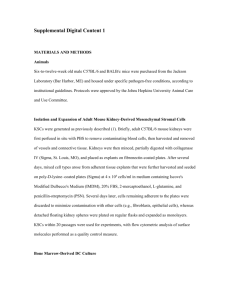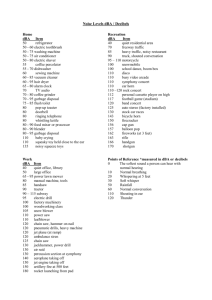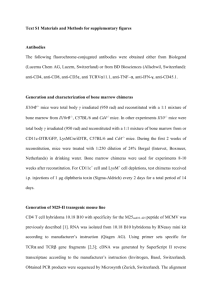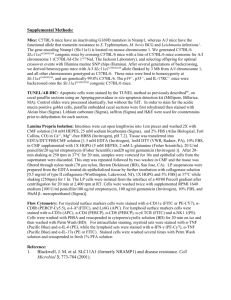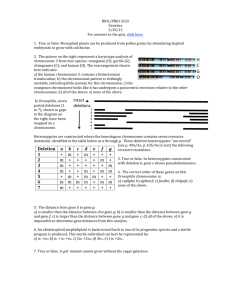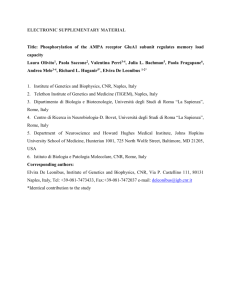Multimodal Approaches to QTL Analysis.
advertisement
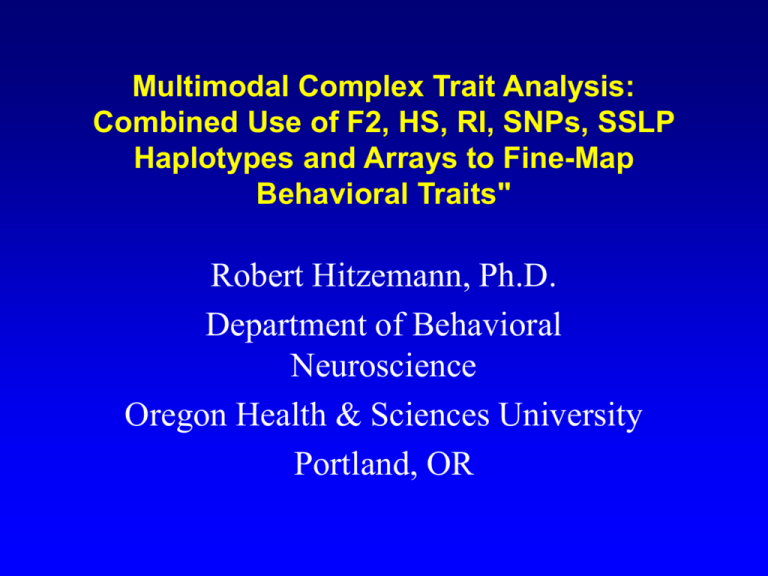
Multimodal Complex Trait Analysis: Combined Use of F2, HS, RI, SNPs, SSLP Haplotypes and Arrays to Fine-Map Behavioral Traits" Robert Hitzemann, Ph.D. Department of Behavioral Neuroscience Oregon Health & Sciences University Portland, OR Phenotype to Gene The Beginning… Schueler HE, Hitzemann RJ, Harris RA, Kreishman GP (1989) Ethanol-induced differential disordering of synaptic plasma membranes from mice selected for genetic differences in ethanol intoxication. Prog Clin Bio Res 292: 425-434. 100 90 80 NR 60 50 50 40 40 30 Percent Percent Responding 70 30 20 NNR NR NNR 20 10 10 0 0 Albino Piebald 0 3 5 7 9 11 14 16 Generation 0 4 8 12 Generation 16 20 24 20 Selective Breeding as a Mode of Contemporary QTL Analysis. • Strong evidence that the phenotype of interest has a measurable heritability • Provides a mechanism for detecting correlated traits and thus potential candidate genes • Both short and long term selective breeding provide instruments for confirming QTLs • Selectively bred animals may prove useful for the fine mapping of QTLs Selective Breeding Phenotype to Gene Selective Breeding Basic Genetics Phenotype to Gene Haloperidol ED50 (mg/kg) +/- S.D. 4 3 2 1 0 Isogenic Generations Segregating Generations B6 BcB6 F1 BcD2 F2 0% 50% Gene Dosage (% D2 alleles) D2 100% Activity - cm/5 min 6000 Basal Activity 5000 C57BL/6J DBA/2J F1 F2 4000 3000 2000 1000 0 5 10 Time 15 20 Activity - cm/5 min 3000 Ethanol-Induced Activity 2500 C57BL/6J DBA/2J F1 F2 2000 1500 1000 500 0 5 10 Time 15 20 Scatterplot: ETHANOL1 vs. ETHANOL1 (Casewise MD deletion) Scatterplot: SALINE1T vs. SALINE1T (Casewise MD deletion) ETHANOL1 = 2621.2 + .26595 * ETHANOL1 Correlation: r = .27391 SALINE1T = 3013.6 + .59582 * SALINE1T Correlation: r = .53850 25000 24000 22000 20000 20000 18000 15000 16000 14000 SALINE1T ETHANOL1 10000 5000 12000 10000 8000 0 6000 -5000 4000 2000 -10000 0 -15000 -20000 -15000 -10000 -5000 0 5000 ETHANOL1 10000 15000 20000 25000 30000 95% confidence -2000 -2000 0 2000 4000 6000 8000 10000 12000 14000 16000 18000 20000 SALINE1T 95% confidence Scatterplot: SALINE1T vs. SALINE1T (Casewise MD deletion) Test - Retest - Total Basal Activity - C57BL/6 x LP SALINE1T = 3013.6 + .59582 * SALINE1T Correlation: r = .53850 Var9 = 442.20 + .68757 * Var8 Correlation: r = .72346 24000 26000 22000 24000 20000 22000 18000 20000 18000 16000 16000 14000 12000 Var9 SALINE1T 14000 10000 12000 10000 8000 8000 6000 6000 4000 4000 2000 2000 0 0 -2000 -2000 0 2000 4000 6000 8000 10000 12000 SALINE1T 14000 16000 18000 20000 95% confidence -2000 -2000 0 2000 4000 6000 8000 10000 12000 14000 16000 18000 20000 22000 Var8 95% confidence Selective Breeding Basic Genetics Phenotype to Gene Recombinant Inbred Strains Key Publications for QTL Analysis in Mice. Plomin R. McClearn GE. Gora-Maslak G. Neiderhiser JM. Use of recombinant inbred strains to detect quantitative trait loci associated with behavior. Behavior Genetics. 21(2):99-116, 1991 Mar. 19 11 28 BXD Strain 20 12 6 25 B6 32 16 18 23 29 7.90 6.67 5.89 4.43 4.18 3.81 3.80 3.62 3.25 2.94 2.80 2.73 2.47 2.39 2.31 1.73 1.53 1.48 1.35 1.23 1.17 1.17 C57L 14 LP 9 129 13 CBA 8 P 27 B6 5 A/He 15 A 1 C3H 21 SJL 31 CE 24 PL 30 D2 D2 22 0.98 6 0.96 4 AKR 0 8 0.93 6 0.61 7 0.55 8 BALB/c 0.4 9 10 Standard Inbred Strains 4 2 5 3 2 1 2 Conditional QTLs (p < 0.01) Obtained from the Analysis of the RI Strain Means • D2Mit238, D2Ncvs31, D2Mit7 (27-30 cM, r = -.54) • D4Mit17, b(Trp1), Ifa (29-42 cM, r = -.62) • D6Mit16, D6Mit9, Tgfa (26-33 cM, r = -.72) • D9Mit4, Ncam, Drd2, D9Mit21 (28-32 cM, r = 0.56) • D15Mit1 (41-48 cM, r = -.65) • D16Mit131 (10 cM, r = .52) 0 5 11q23-q24 15 20 25 11q23-q24 11q23-q24 15q23-q24 15q22-q24 Drd2 (0.55) 30 35 Fli-1 (0.33) Lap-1 (0.27) Xmv-16 (0.40) T3d (0.40) Apoa-1 (0.40) Ncam, D9Mit22 (0.55) D9Mit4, D9Byu1b (0.54) Xmv-15 (0.38) 40 d D9Mit8 (0.04) 45 Htr1b 50 Chromosome 9 Key Publications for QTL Analysis in Mice. Plomin R, McClearn GE, Gora-Maslak G, Neiderhiser JM (1991) Use of recombinant inbred strains to detect quantitative trait loci associated with behavior. Behavior Genetics. 21(2):99-116. Belknap JK, Mitchell SR, Crabbe JC (1996) Type I and II error rates for quantitative trait loci (QTL) mapping studies using recombinant inbred mouse strains: Computer simulation and empirical results. Behavior Genetics 26:581-592. Key Publications for QTL Analysis in Mice. Dietrich W, Katz H, Lincoln SE, Shin HS, Friedman J, Dracopoli NC, Lander ES (1996) A genetic map of the mouse suitable for typing intra-specific crosses.Genetics. 131(2):423-47. Flint J, Corley R, DeFreis JC, Fulker DW, Gray JA, Miller S, Collins AC (1995) A simple genetic basis for a complex psychological trait in laboratory mice. Science 269: 1432-35 Selective Breeding Basic Genetics Intercross Mapping Phenotype to Gene Recombinant Inbred Strains Phenotype = Haloperidol-Induced Catalepsy Cpu3 El1 Acra3 Htr1b Myo5a El4 Grik4 Scn2b Ncam Drd2 Acat1 Acra5 Acra5 Penk2 Gria4 D9Mit212 D9Mit111 D9Mit74 D9Mit144 D9Mit22 D9Mit21 D9Mit206 D9Mit188 D9Mit90 2 LOD Phenotype = Ethanol-Induced Locomotor Activation 6 1 D2MIT229 D2MIT458 D2MIT241 D2MIT94 D2MIT420 D2MIT102 D2MIT491 D2MIT493 D2MIT412 D2MIT282 . . . . . . .. .. D2MIT521 .. . I Free Dominant Recessive Additive 10 cM 0 D2MIT464 D2MIT80 Ntsr Lorr2 Snap25 Adra2b Plcb2 Kcna1-rs2 Gad1 Scn1a Alcp1q N = 600 Chromosome 2 5 4 3 Ethanol-Induced Locomotor Activation 30 F-Value 25 B6D2 Intercross 0 - 5 Min 5 - 10 Min 10 - 15 Min 15 - 20 Min 20 15 10 5 0 0 N = 1820 20 40 cM 60 Chromosome 2 80 100 50 Comparison of IM and CIM Techniques 40 LOD 30 20 10 0 0 1 Relative Chromosome Length 10 14 8 Additive Free Additive 12 6 10 LOD LOD Ethanol Response 10-15 Min (CIM) 16 Ethanol Response 0-5 Min (CIM) 4 2 Free 8 6 4 Dominant Dominant 2 0 0 0 20 40 60 80 cM - Chromosome 2 100 120 0 Ethanol Response 5-10 Min (CIM) 10 40 60 80 cM - Chromosome 2 100 120 Ethanol Response 15-20 Min (CIM) 14 12 8 Additive Free 10 6 8 LOD LOD 20 4 Free Additive 6 4 2 Dominant 2 0 Dominant 0 0 20 40 60 80 cM - Chromosome 2 100 120 0 20 40 60 80 cM - Chromosome 2 100 120 Evidence for epistasis – basal locomotor activity D1Mit365 ------- B6:B6 B6:D2 D2:D2 --:-- D8Mit236 --------------------------------------------------------------------------------------------:-- B6:B6 B6:D2 D2:D2 2660 + 88 2180 + 95*** 1790 + 58**** 2250 + 166*** 2380 + 113 1870 + 172 2300 + 115 2650 + 238 2090 + 88 1910 + 106 2080 + 113 3080 + 198 2090 + 173 1600 + 280 2260 + 98 Koyner et al. 2000 Selective Breeding Fine Mapping Basic Genetics Phenotype to Gene Recombinant Inbred Strains Intercross Mapping Key Publications for QTL Analysis in Mice. Darvasi A (1998) Experimental strategies for the genetic dissection of complex traits in animal models. Nature Genetics 18: 19-24. Talbot CJ, Nicod A, Cherny SS, Fulker DW, Collins AC, Flint J (1999) High resolution mapping of quantitative trait loci in outbred mice. Nature Genetics 21: 305-308. Threadgill DW, Hunter KW, Williams RW (2002) Genetic dissection of complex and quantitative traits: from fantasy to reality via a community effort. Mammalian Genome 13: 175-8. Strategies for Fine Mapping (< 1 cM) QTLs. • • • • Interval specific congenic strains Advanced F2 intercrosses Heterogeneous stock (HS) > G30 Large (~1,000 strains) recombinant inbred panels – also includes the use of RIX animals • The integration of functional genomics and QTL analysis Ethanol-Induced Locomotor Activation 30 F-Value 25 B6D2 Intercross 0 - 5 Min 5 - 10 Min 10 - 15 Min 15 - 20 Min 20 15 10 5 0 0 20 40 cM 60 80 100 N = 1820 30 0 - 5 Min 5 - 10 Min 10 - 15 Min 15 - 20 Min F-Value 20 10 0 -10 HS Population -20 45 50 55 60 cM N = 550 @ G32 Chromosome 2 65 70 75 Mechanism & Circuit Basic Genetics Selective Breeding Phenotype to Gene Recombinant Inbred Strains Intercross Mapping Fine Mapping Fos Positive Cells / Section 80 Central Amygdaloid Nucleus DBA 60 C57 40 20 0 0.25 0.5 1 Ethanol - g/kg 2 4 GABA (Peptide) DA, NE 5-HT, ACh BST 4 Glu (Peptide) GABA (Peptide) GABA 2 5 3 CeL 1 CeM Glu (Peptide) Ins Cx, , PB Motor Response Multiple Cross Mapping (MCM): A New Recipe for QTL Measurement and Gene Detection Multiple Cross Mapping (MCM) • Builds from the observation that for open-field/basal activity, three different diallele crosses (B6xC, B6xA and B6xD2) appear to generate some similar QTLs, most notably on distal chromosome1 (Hitzemann et al. 2000). One interpretation of these data would be that the C, A and D2 strains have common allele(s) in the region of interest. • The more general interpretation is that polymorphic and non-polymorphic alleles are not randomly distributed and thus, provide a source of information. MCM can be used to “mine” this information to reduce the QTL interval. • MCM provides a mechanism to interrogate the data obtained from gene and protein array analysis. Ingredients for MCM (v2.0) • Four inbred mouse strains – C57BL/6J (B6), DBA/2J (D2), BALB/cJ (C) and LP/J (LP). • The six F2 intercrosses that can be produced from these four strains. • A four-way cross of the strains – Heterogeneous Stock 4 (HS4) at G11. • An eight way HS at G44 containing the above four strains plus the AKR/J, A/J, C3H/HeJ and CBA/J strains (HS8). • Chromosome-gene expression maps for the inbred strains. • Dense microsatellite and SNP maps for the inbred strains. • Multiple phenotypes: basal activity, ethanol-induced activity, haloperidol-induced catalepsy, the acoustic startle response (ASR) and pre-pulse inhibition (PPI) of the ASR. QTL Maps - Ethanol Response 6 5 C57BL/6 x DBA/2 C57BL/6 x LP C57BL/6 x BALB/c -Log P 4 3 2 1 0 0 20 40 60 80 100 120 60 80 100 120 6 5 C57BL/6 x DBA/2 BALB/c x DBA/2 DBA/2 x LP BALB/c x LP -Log P 4 3 2 1 0 0 20 40 cM - Chromosome 1 0.35 Fraction of Total Markers Fraction of Total Markers 0.14 0.12 0.10 0.08 C57BL/6 vs DBA/2 Distribution of Marker Set Based On QTL Criteria 0.30 0.25 0.20 Polymorphic Not Polymorphic 0.15 0.10 0.05 0.00 0 20 40 60 80 100 120 Chromosome 1 - cM 0.06 0.04 0.02 0.00 0 20 40 60 80 Chromosome 1 - cM 100 120 Table 1: Analysis of Chromosome 1 QTL for Ethanol Response in HS Mice 11 Markers (Catalog Position-cM) Calculated Interval - cM - Log P 0 1 D1Mit 103(73) - D1Mit423(73) D1Mit423(73) - D1Mit 100(71.5) 64.100 - 64.730 64.730 - 64.760 2.46 2.68 2 D1Mit 100(71.5) - D1Mit496(70) 64.760 - 64.840 3.18 3 4 D1Mit496(70) - D1Mit264(71.5) D1Mit264(71.5) - D1Mit289(74.3) 64.860 - 64.960 64.960 - 65.170 3.30 5.86 5 D1Mit289(74.3) - D1Mit425(81.6) 65.170 - 68.010 13.5 6 D1Mit425(81.6) - D1Mit268(83.4) 68.010 - 71.980 12.7 7 8 D1Mit268(83.4) - D1Mit452(86.6) D1Mit452(86.6) - D1Mit16(87.2) 71.980 - 73.880 73.880 - 75.100 10.8 2.72 9 D1Mit16(87.2) - D1Mit370(87.9) 75.100 - 77.280 2.99 10 11 D1Mit370(87.9) - D1Mit110(88.1) D1Mit110(88.1) - D1Mit15(87.9) 77.280 - 77.550 77.550 - 77.960 2.99 3.51 12 D1Mit15(87.9) - D1Mit270(92.3) 77.960 - 80.270 1.91 13 14 D1Mit270(92.3) - D1Mit36(92.3) D1Mit36(92.3) - D1Mit113(93.3) 80.270 - 80.800 80.800 - 81.400 0.91 3.06 15 D1Mit113(93.3) - D1Mit402(92.3) 81.400 - 81.900 1.95 16 17 D1Mit402(92.3) - D1Mit149(94.2) D1Mit149(94.2) - D1Mit354(95.8) 81.900 - 82.500 82.500 - 82.600 1.26 0.39 18 D1Mit354(95.8) - D1Mit456(95.8) 82.600 - 82.800 0.33 19 DiMit456(95.8) - D1Mit541(97.7) 82.800 - 83.500 0.41 20 D1Mit541(97.7) - D1Mit115(99.7) 83.500 - 84.340 2.71 The Problem. “All genetic studies begin with variation because perturbations in biological processes reveal functionally important elements in the life history of an organism. Naturally occurring variation still drives many studies because complex genetic traits remain important in humans, model organisms and agriculturally important animal and plant species. The existing challenge in complex trait analysis is to distinguish the mutations responsible for trait variability from closely linked, selectively neutral polymorphisms.” Nadeau and Dunn (1998) Gene Expression Project • Affymetrix “A” chip & 16,000 gene cDNA arrays for some groups of interest • Whole brain data in C57BL/6, DBA/2, BALB/c, LP, A, AKR, C3H/He, CBA and 129/SV – N=6-8/strain • Data from extended amygdala (CeA+BSTLP) and dorsomedial striatum both at baseline and after acute haloperidol (1 mg/kg) or acute ethanol (1.5g/kg) treatment; data will be obtained in C57BL/6, DBA/2, BALB/c, LP, A and 129/SV strains – N=6-8/strain • Purpose: to construct chromosome expression maps for the various strains and to integrate expression maps with sequence maps • Samples from other brain regions have been collected e.g. VTA, SNc, Cb and are available for analysis Results of the Gene Expression Project to Date • Whole brain data (Affymetrix) have been obtained from 4 strains (B6, D2, C and LP) – N = 6 • ~6000 transcripts were detected as present in one or more of the strains; the actual number of genes expressed will be substantially fewer given that some genes have multiple transcripts • ~ 1900 transcripts were detected as being differentially expressed among the four strains at p < 0.05 • ~ 400 transcripts were detected as being differentially expressed among the four strains at p < 0.000005 Chromosome 2 Gene cM F-value glutamate receptor, ionotropic, NMDA1 (zeta 1) prostaglandin D2 synthase (21 kDa, brain) prostaglandin D2 synthase (21 kDa, brain) prostaglandin D2 synthase (21 kDa, brain) heat shock 70kD protein 5 (glucose-regulated protein, 78kD) pre B-cell leukemia transcription factor 3 gelsolin tumor necrosis factor induced protein 6 neurogenic differentiation 1 CD59a antigen reticulocalbin secretory granule neuroendocrine protein 1, 7B2 protein maternal inhibition of differentiation beta-2 microglobulin protein tyrosine phosphata cystatin C inhibitor of DNA binding 1 neuronatin protein kinase inhibitor, gamma protective protein for beta-galactosidase SRY-box containing gene 18 potassium voltage-gated channel, subfamily Q, member 2 myelin transcription factor 1 sialyltransferase 7 transcription termination factor 1 c-mer proto-oncogene fibroblast growth factor 7 isovaleryl coenzyme A dehydrogenase 12 13 13 13 22 22 25 30 46 55 58 64 68 69 73 84 84 88 94 96 96 104 106 7 12 8 7 13 8 26 19 6 50 15 129 10 27 6 21 19 55 67 9 7 21 10 7 7 9 25 43 QTL Maps Ethanol Response 600 Diff. Score 14 12 C57BL/6 x DBA/2 BALB/c x DBA/2 LP x DBA/2 F value 10 Reticulocalbin 500 400 300 200 100 0 8 C57BL/6 DBA/2 BALB/c LP/J 6 4 2 2000 Sgne1 0 20 40 60 80 Diff. Score 0 100 14 C57Bl/6 x DBA/2 C57BL/6 x BALB/c LP x BALB/c C57Bl/6 x LP 12 8 1000 500 0 C57BL/6 DBA/2 BALB/c LP/J 6 4 2 120 0 100 Microglobulin 0 20 40 60 80 Chromosome 2 - cM 100 120 Diff. Score F Value 10 1500 Beta-2 80 60 40 20 0 C57BL/6 DBA/2 BALB/c LP/J D2 = C = LP Cas1 Catalase Activity QTL Maps Ethanol Response 14 12 C57BL/6 x DBA/2 BALB/c x DBA/2 LP x DBA/2 F value 10 8 6 4 2 140 130 120 110 100 90 80 70 60 RI-#32 RI-#11 RI-#28 D2 RI-#16 RI-#6 RI-#1 B6 B6 D2 Allele 0 0 20 40 60 80 100 14 C57Bl/6 x DBA/2 C57BL/6 x BALB/c LP x BALB/c C57Bl/6 x LP 12 F Value 10 8 Bdnf 6 4 2 0 0 20 40 60 80 Chromosome 2 - cM 100 120 B6 Leu D2 Met C Met LP Leu QTL Maps - Basal Actvity 25 B6 vs D2 B6 vs LP B6 vs C F-value 20 15 10 5 0 0 20 40 60 80 100 120 40 60 80 100 120 25 B6 vs D2 LP vs D2 Lp vs C C vs D2 F value 20 15 10 5 0 0 20 cM - chromosome 1 Chromosome 1 Gene Eph receptor A4 myosin Ib acetyl-Coenzyme A dehydrogenase, long-chain isocitrate dehydrogenase 1 (NADP+), soluble insulin-like growth factor binding protein 5 insulin-like growth factor binding protein 2 peptidylglycine alpha-amidating monooxygenase troponin T2, cardiac astrotactin 1 POU domain, class 2, transcription factor 1 pre B-cell leukemia transcription factor 1 peroxisomal farnesylated protein potassium inwardly-rectifying channel, subfamily J, member 9 ATPase, Na+/K+ transporting, alpha 2 polypeptide LanC (bacterial lantibiotic synthetase component C)-like growth arrest specific 5 transcription elongation factor A (SII) 1 kinesin heavy chain member 1A expressed sequence C77892 cM F-value 7 25 27 30 36 36 58 60 85 87 88 93 94 94 6 6 7 6 23 8 61 11 7 17 6 13 172 7 104 61 55 22 9 Diff. Score QTL Maps - Basal Actvity 25 B6 vs D2 B6 vs LP B6 vs C F-value 20 15 180 160 140 120 100 80 60 40 20 0 Pxf C57BL/6 DBA/2 BALB/c LP C57BL/6 DBA/2 BALB/c LP 10 GIRK3 5 600 0 20 40 60 80 100 120 25 B6 vs D2 LP vs D2 Lp vs C C vs D2 15 400 300 C57BL/6 DBA/2 BALB/c LP 200 100 0 10 5 0 0 20 40 60 80 cM - chromosome 1 100 120 Diff. Score F value 20 Diff. Score 500 0 1800 1600 1400 1200 1000 800 600 400 200 0 Atp1a2 Polymorphisms Between the C57BL/6J and DBA/2J Strains in Kcnj9 (GIRK3) 1 gggaacctag ggtactgggg gagatggtgt cagggacatg gacgccaacc cccaagggtt 61 tctgctgctg gctactcttc tctccaggct ctgggaccct gaaagcctag gaaccgactc 121 tggccatcca tctctccggg aagattataa cccagagtgc ttctcagggg ggaagaattt 181 gaagcaaaac cagaccccgc aggatccccg ctgcggccgc catgcgccag gagaacgccg 241 ctttctctcc cgggtcggag gagccgccac gccgccgcgg tcgccagcgc tacgtggaga ……….. 481 gcgacctgga gcacctggag gacaccgcgt ggaccccgtg cgtcaacaac ctcaacggct 541 tcgtggccgc cttcctcttc tccatagaga cggagaccac carcggctat gggcaccgcg ……….. 781 gtctcagtt tcgcgtgggc gaccctgcgat cctcacacat cgtcgaggcc tccatccgag ……….. 1081gccaagctcg aagctcgtac ctggtggatg aagtgttgtg gggccaccgg ttcacatccg ……….. 1201aggtgcccac accctcgtcg agtgcttcggg aactggcaga agccgcggcc cgccttgatg ………… GABA Related Genes Gene Chr cM Gabra1 Gabra2 Gabra6 Gabrb1 Gabrb2 Gabrb3 Gabrg1 Gabrg2 Gabrg3 Gabt1 Gad1 Gad2 11 5 11 5 11* 7 5 11 7 3 2 2 19cM 40cM 23cM 40cM *25cM 29cM 40cM 19cM 28cM 50cM 43cM 9cM Viaat 2 80cM F-value P-value C57BL/6J DBA/2J LP/J BALB/cJ 16.7756 17.5145 13.5512 13.5435 10.0278 1.8440 5.8868 3.0945 1.3917 0.4664 3.0010 2.1515 0.000011 0.000008 0.000047 0.000047 0.000304 0.171715 0.004744 0.050183 0.274346 0.708949 0.054809 0.125644 98 0.000000 Mean + SD (N=6/strain) 526+44 298 + 15 505 + 59 497 + 103 51 + 18 140 + 29 125 + 26 132 + 23 672 + 81 848 + 89 901 + 57 922 + 71 965 + 85 1085 + 101 769 + 78 969 + 83 34 + 14 2+6 44 + 17 46 + 21 69 + 23 83 + 22 99 + 28 86 + 17 40 + 8 51 + 9 64 + 14 57 + 10 801 + 45 881 + 72 902 + 77 888 + 54 71 + 25 87 + 17 80 + 11 91 + 15 1064 + 90 1105 + 76 1110 + 65 1092 + 58 1900 + 116 1973 + 123 2055 + 123 2082 + 93 61 + 16 75 + 13 84 + 19 89 + 29 1434 + 70 748 + 109 1494 + 88 1456 + 80 Comparison of GABA Receptor a-Subunit Gene Expression in Whole Brain, the Dorsomedial Striatum and the Central Extended Amygdala. Gene Chr Gabra1 11 DBA/2J LP/J Mean + SD (N=3-6/strain) 19cM WB 526 + 44 298 + 15 505 + 59 Striatum (DM) 272 + 106 143 + 41 195 + 55 CeA-BSTLP 475 + 35 220 + 19 318 + 29 Gabra2 5 40cM Gabra3 X Gabra6 11 A = absent cM 23cM Region C57BL/6J BALB/cJ 497 + 103 258 + 23 386 + 56 WB Striatum (DM) CeA-BSTLP 51 + 18 57 + 17 108 + 10 140 + 29 186 + 21 211 + 44 125 + 26 168 + 32 217 + 24 132 + 23 196 + 15 213 + 59 WB Striatum (DM) CeA-BSTLP A A 40 + 17 A A 25 + 8 A A 33 + 13 A A 23 + 21 WB Striatum (DM) CeA-BSTLP 672 + 81 10 + 4 A 848 + 89 8+6 A 901 + 57 20 + 18 A 922 + 71 13 + 6 A QTLs and GABA Related Gene Expression • Chr 11 (a1, a6, b2, g2) – Acute pentobarbital withdrawal, acute alcohol withdrawal, forced swim test, light-dark latency, tail suspension • Chr 5 (a2,b1,g1) – kianic acid induced seizures, PTZ induced seizures, alcohol hypothermic sensitivity and tolerance, (elevated plus maze behavior) • Chr 2 (Viaat) – acute locomotor response to ethanol and chlordiazepoxide QTL Maps - Ethanol Response 6 5 C57BL/6 x DBA/2 C57BL/6 x LP C57BL/6 x BALB/c -Log P 4 3 2 1 0 0 20 40 60 80 100 120 60 80 100 120 6 5 C57BL/6 x DBA/2 BALB/c x DBA/2 DBA/2 x LP BALB/c x LP -Log P 4 3 2 1 0 Ethanol-Induced Response cm/20 min 6000 5000 Genotype vs Response at D1Mit150 Four-way Cross 4000 3000 2000 1000 0 B6:B6 C:C B6:D2 B6:LP D2:LP D2:D2 LP:LP B6:C D2:C C:LP 0 20 40 cM - Chromosome 1 Mechanism & Circuit Basic Genetics Selective Breeding Multiple Cross Mapping Phenotype to Gene Recombinant Inbred Strains Functional Genomics Intercross Mapping Fine Mapping Complex Trait Probable Gene Intestinal tumor resistance Pla2g2a Mom1 [mice] Type II diabetes-insulin resistance [rats] Cd36 Type I diabetes- Idd3 islet degeneration [mice] Allergen-induced airway hyperresponsivenessasthma [mice] Susceptibility to lupus [mice] Cardiac ventricular hypertrophy [rats] Blood pressure [rats] Sweet taste preference behavior [mice] Cd5 Ifi202 Nppa Cyp11b1 Tas1r3 Reference Cormier et al., 1997 Nature Genet 17:88 Aitman et al., 1999; Pravenac et al., 2001, Nature Genet 16:197 & 27:156 Lyons et al., 2000 Genome Res 10:446 Karp et al., 2000 Nature Immun 1:221 Rozzo et al., 2001 Immunity 15:435 Deschepper et al., 2001 Circul Res 88:223 Cicila et al., 2001 Genomics 72:51 Max et al., 2001 Nature Genet 28:58 JKB, Dec 2001 Complex Trait Probable Gene Method of gene ID Intestinal tumor resistance Pla2g2a Mom-1 [mice] Type II diabetes-insulin resistance [rats] Cd36 Type I diabetes- Idd3/Il2 islet degeneration [mice] Allergen-induced airway hyperresponsivenessasthma [mice] Susceptibility to lupus [mice] Cardiac ventricular hypertrophy [rats] Blood pressure [rats] Sweet taste preference behavior [mice] Cd5 Ifi202 Nppa Cyp11b1 Tas1r3 High res mapping/Transgenic rescue Microarray analysis in congenic vs background strain/ transgenic rescue Mapping to 780 kb/ functional testing Microarray analysis in congenic vs background strain Microarray analysis in congenic vs background strain/functional Promotor SNP/functional testing/in vitro expression Mapping to 220kb/SNPs/ functional testing Taste cell specific expression/ glycosylation site SNP/ functional testing. JKB, Dec. 2001 25 Number of QTLs 20 15 Distribution of Some Murine Behavioral QTLs - LOD > 3 Total Number of QTLs = 124 10 Aggression Circadian Rhythm Drug Preference Drug Response Emotion Learning Motor Activity 5 0 1 2 3 4 5 6 7 8 9 10 11 12 13 14 15 16 17 18 19 X Chromosome Acknowledgements Stony Brook OHSU Denver Jim McCaughran Laura Cipp Kristin Demarest Jay Koyner Stephen Kanes Nilay Patel Erik Rasmussen Barbara Hitzemann Yifang Qian Peter Thanos Adena Svingos Barry Malmanger Shannon Coulombe Staci Cooper Cheryl Reed Barbara Hitzemann Maureen Lawler Kristin Hitzemann Tarra Gupta Ronnie Dhamer Jim Sikela Yan Xu Kari Buck Brooks Rademacher Oxford, UK Jonathan Flint Chris Talbot

